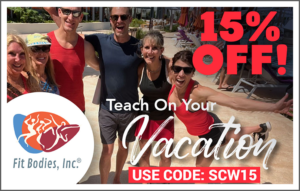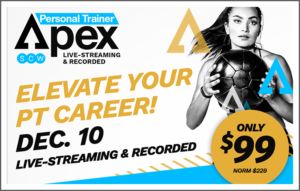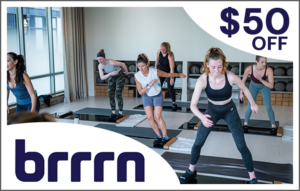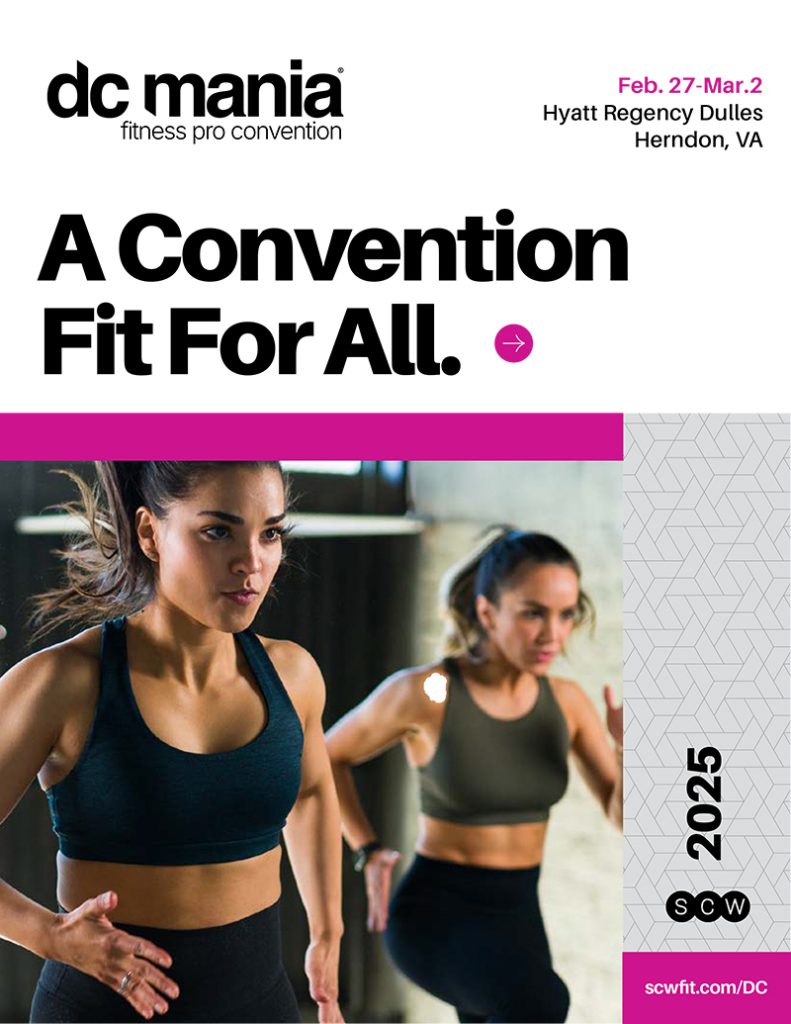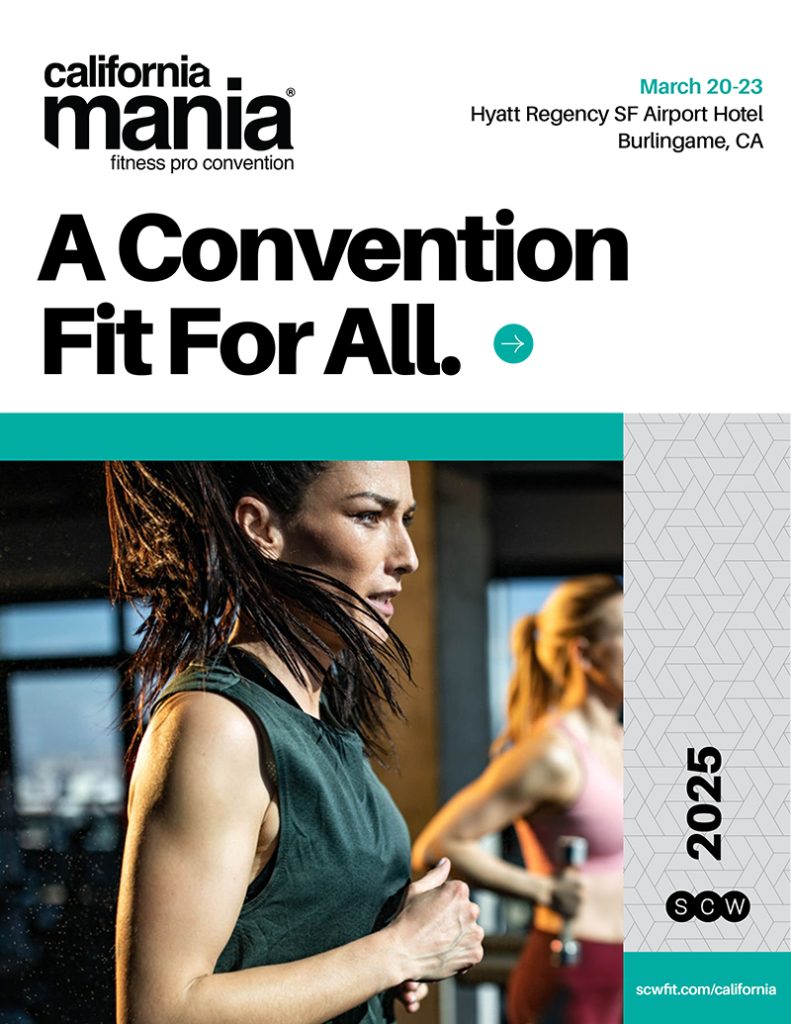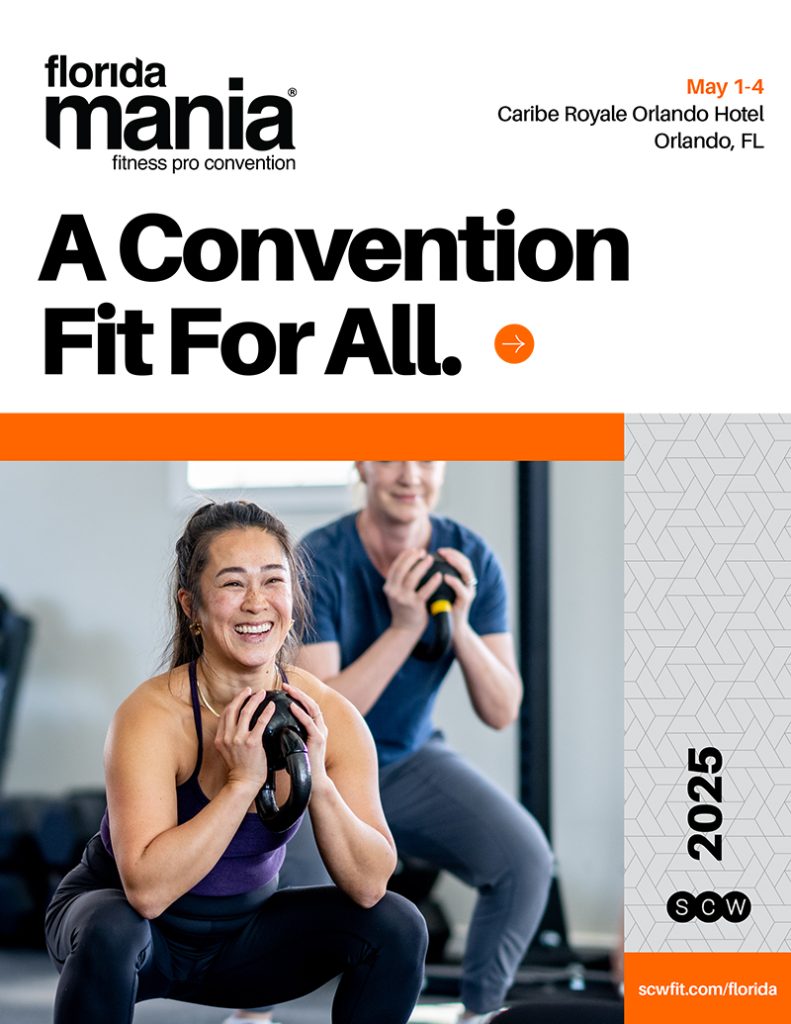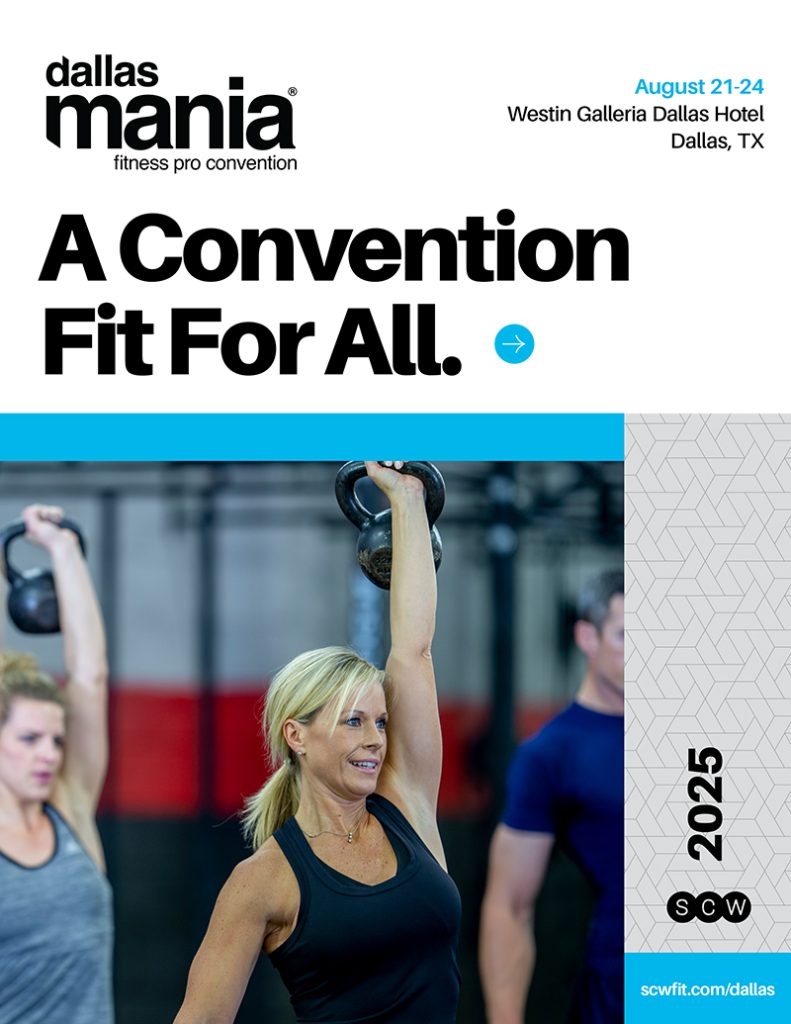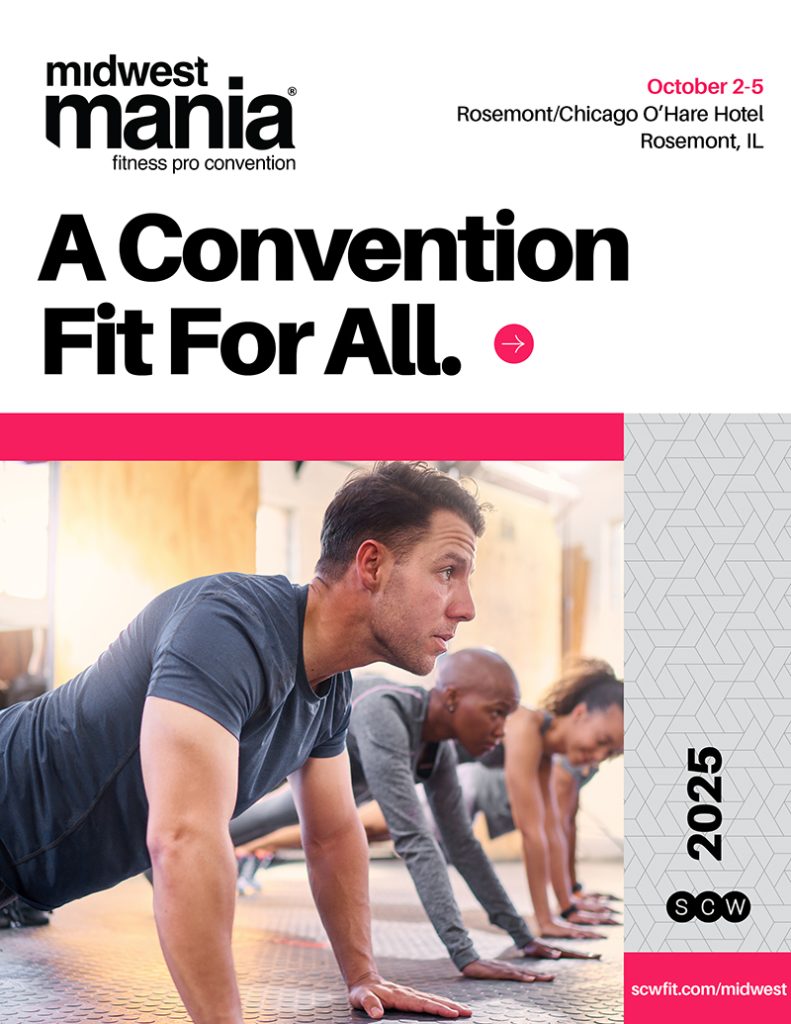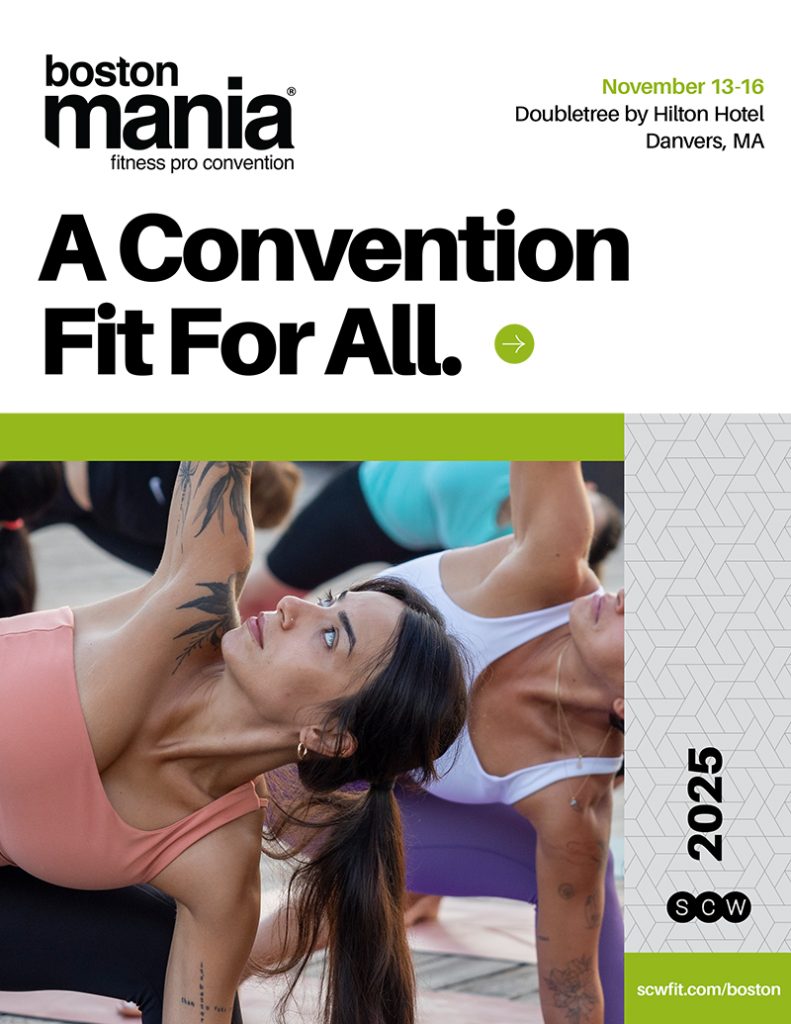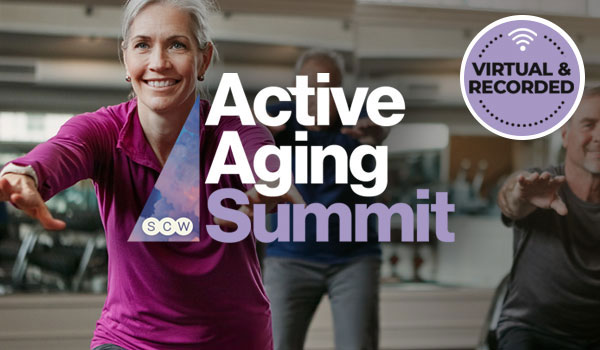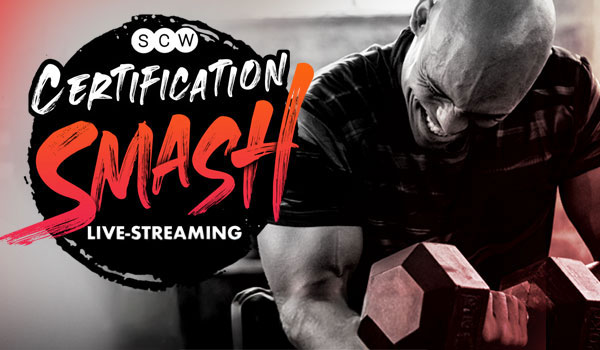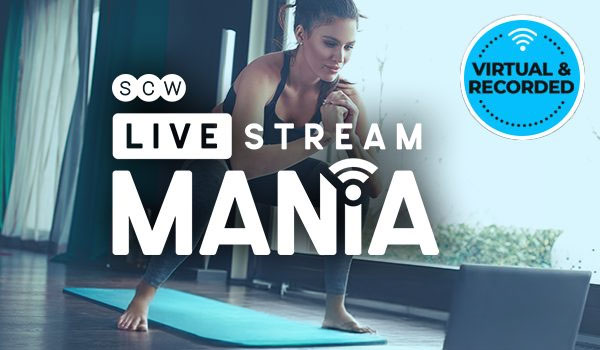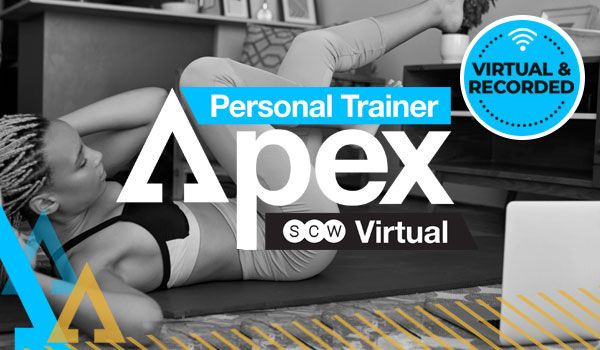
SCW Spotlite: Issue 51

Oh, Yes You Can: Exercise After Breast Cancer Surgery
by Ann Gilbert
Breast Cancer is the most common type of cancer in women, but according to the American Cancer Society, it has the highest survival rate of any in the books. There is a multitude of research that studies the effects of regular exercise in patients or clients diagnosed with breast cancer. Evidence shows that regular exercise after diagnosis improved mortality, fatigue, and overall quality of life, not to mention emotional wellbeing. Thus, exercise is now seen as a treatment in positive physiological and psychological improvements after breast cancer surgery.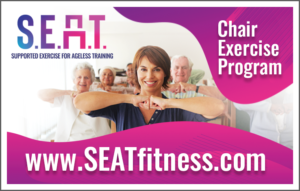
General Guidelines: As with any type of post-surgery exercise regimen, be sure to get the A-OK from your doctor.
As Personal Trainers, Small or Group Ex Instructors, when starting a new workout program for these specialized clients, it is important to start with the basics. The most common, beginner movement is simply raising your arms to shoulder height and back down. A move like this can be repeated as many as 3-4 times a day. This particular pattern will not only restore mobility but move lymph fluid out of your arm area to help prep for the more advanced activities of daily life. Next, is to work on the muscles surrounding the elbow. Try to flex and extend the elbow joint while seated in a comfortable chair and touch your fingers to your chest, shoulder, and then over your shoulder if it feels comfortable. Repeat as many as 20 times and be mindful of your breathing, inhaling, and exhaling with deliberate focus on expanding the diaphragm. (Stop all movement patterns if swelling or tenderness occurs.)
When participating in regular exercise there is a 50% reduced risk of recurrence in our group when compared to the sedentary groups. Other benefits include a decrease in depression and anxiety, and an increase in sleep. All of which are a challenge during the treatment weeks following surgery.
As a certified trainer and breast cancer survivor, I recommend two types of exercise structures which are appropriate for survivors in weeks 4-12 post-surgery. First, seek out a well-planned seated chair program. Search for a detailed format in which each segment has a clear purpose, allowing the survivor to focus on mobility, postural alignment, memory, balance, and resistance training. The agenda should address all aspects of fitness for the patient, client, or student returning to your facility or online sessions.
The use of a chair as a stabilization tool will allow for an increase in overall confidence as the patient restarts the fitness journey. Choose the program that allows for a slow increase in lever (arm length), thoracic rotation, as well as single leg movements and essential joint movements addressing speed, power, and even balance.
Also, look for one which develops a communication trail with the survivor’s treatment team. They will become immediate networking partners and contributors for future clients and students.
Next, encourage water fitness. The properties of buoyancy, drag, and viscosity make the aquatic environment very appropriate of the survivor. The survivor will feel light and playful and be less self-conscious once chest deep. The effects of hydrostatic pressure will shorten the conditioning phase of the exercise program and aid in overall recovery.
The following movements can be completed in a chair, in the pool, or when lying down in the supine position. Let’s get started.
Exercise 1. Increase the mobility of the shoulder by gently sliding a small towel up the wall while standing a few inches from the wall. If seated, gentle slide the small towel along the length of the thighs.
Repeat the movement 5-10 times.
Exercise 2. While sitting in a chair with a lengthened spine and with weight in your heel, flex the spine from right to left, while holding your hands over your head.
Repeat the movement 5-10 times.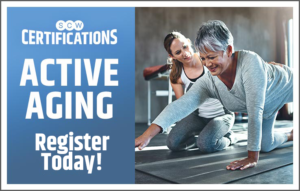
Exercise 3. Commonly called the open-door stretch, the “w” position of the arms allows for an aggressive stretch of the pectorals and a reciprocal contraction through the postural muscles of the mid back or thoracic region. Bend the elbows in what would be considered a “w”, sliding the elbows down towards the hip joint. Plank forward slightly as if to fall through an open door. Return to the starting position.
Repeat the movement 5-7 times.
Exercise 4. Lie in the supine position with knees bent. Gently slide a ruler, wand or broom stick over the head starting at the belly. The elbows stay soft, and the focus is on increasing the range of motion at the shoulder area. While in that position one can bend the elbows and slide the fingers behind the upper back while moving in a wing in and wing out pattern.
Repeat the movement 5-7 times.
Exercise is safe and very feasible for breast cancer survivors. In most cases, it is prescribed as a part of a treatment plan within 4-12 week of surgery. Exercise has an impact on mortality, prognosis, and overall quality of life. I recommend a multidisciplinary approach that includes both strength and aerobic exercise.
In conclusion, I would like you all to know that early detection, aggressive nutritional change, and exercise consistency have all been instrumental in my physical and mental growth in the past year. The word “remission” is whispered nightly as I say my amens and lay that head on the pillow and plan my exercise for the next day.
 About the Author: Ann Gilbert
About the Author: Ann Gilbert
CANCER SURVIVOR (In remission since June 2021)
Creator of S.E A.T. Supported Exercise for Ageless Training (www.seatfitness.com)
Master Trainer WATERinMOTION® (www.waterinmotion.com)

Yoga is an Anti-Ager
Yoga has been practiced for more than 5,000 years, and evidence that benefits both body and mind are continually being uncovered. Could yoga hold the key to the fountain of youth?
The positive impact yoga has on the body has been shown to reverse the aging process: It reduces body fat and slows weight gain, gives elasticity to muscles, tones tendons and ligaments, improves posture, slows the heart rate, and relaxes the mind. Yoga promotes balance inside and out, which is vital for healthy aging.
So how does yoga specifically contribute to healthy aging?
* Yoga promotes better balance. According to the National Center for Injury Prevention and Control, falls are the leading cause of injury and injury-related deaths in people over 65. At least 30% of all seniors fall each year – 50% after age 80 – and research has shown that those who fall are two to three times more likely to fall again. Better balance is crucial to preserving independence in active-agers and even can be lifesaving.
According to a study by Temple University in 2008, basic yoga moves could help prevent falls in people over the age of 65. Researchers examined the walk and balance of 24 seniors who then were enrolled in a yoga program specifically designed for active aging. At the end of the nine-week program, the researchers found that the participants had a faster stride, increased flexibility, an improved single-leg stance and increased confidence in walking and balance.
Yoga is a workout of gentle movements that strengthens the back and shoulders and increases flexibility, coordination, joint mobility and balance, all which are important keys to aging well.
* Yoga sharpens the mind. Yoga doesn’t just make your body more flexible, it also works your brain. Yoga has been shown to lower the body’s cortisol levels. Elevated levels of cortisol may contribute to memory-related issues like dementia and Alzheimer’s disease. In a study published in June 2015 in the Journal of Neuroscience Nursing, 133 adults ages 53 to 96 practiced 30 minutes of yoga twice a week for more than a month. The participants reported significant gains in memory performance and fewer depressive symptoms.
A study at the University of Illinois at Urbana-Champaign in 2014 followed 108 adults between the ages of 55 and 79; 61 participated in yoga three times a week for eight weeks, and the rest engaged in stretching and toning. At the end of the eight weeks, the yoga group was speedier and more accurate on tests of information recall, mental flexibility and task-switching than before the study. The other group saw no significant change. The researchers reported that practicing yoga three times a week for eight weeks improves sedentary older adults’ performance on cognitive tasks that are relevant to everyday life.
* Yoga relieves stress. Studies show that yoga has a greater impact on enhancing mood and reducing anxiety than other forms of exercise because it lowers the body’s levels of cortisol, the stress hormone, and boosts levels of the brain chemical GABA, which helps calm nerves. Research out of the Boston University School of Medicine and Harvard’s McLean Hospital found that people who practiced yoga for one hour increased their levels of GABA by 27% compared to the control group that sat and read for that same hour.
* Yoga relieves menopause symptoms. With today’s life expectancy increasing, women will spend one-third of their life after menopause. Many women turn to yoga to help them cope with the symptoms of menopause, from hot flashes to mood swings to insomnia. A recent study in Brazil studied how yoga affected insomnia symptoms in a group of 44 postmenopausal women. Compared with women who did passive stretching, the yoga practitioners showed a big drop in the incidence of insomnia. Research shows that yoga also can help reduce hot flashes and depression, too.
* Yoga is a fountain of youth. According to a 2014 study conducted in India, intensive daily yoga practice increases two key substances linked to youth and longevity: growth hormone (GH) and dehydroepiandrosterone sulphate (DHEAS). GH is a hormone that stimulates cell growth and generates new tissue, like skin and muscle. DHEAS is a hormone produced in the adrenal gland that is linked to immune function and cardiovascular health, among other factors. The levels of GH and DHEAS in our bodies decrease significantly as we age.
The study is among the first to explore whether yoga impacts biochemical markers of healthy aging. The results? The participants who practiced yoga two times a week for 12 weeks had significant increases in GH and DHEAS levels, along with notable decreases in body mass index (BMI).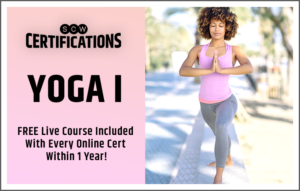
According to the U.S. Census, the country’s population age 65 and older is growing at a faster rate than the U.S. population as a whole. Not only will an Active-Aging Yoga program benefit the older population in body and mind, yoga also has been proven to have healing properties (see Part 2 for that surprising information).
Do you want to learn how to teach seniors how to feel their best? I have been guiding active-agers through yoga programs for years, and I know how important it is to stress proper form. My video Yoga for the Young at Heart focuses on helping active-agers avoid falls and injuries, maintain independence and improve their quality of life. My workshop offers practical recommendations every instructor can use to lead active 50- to 90-year-olds through safe and effective movements using both a chair and a mat.
In the coming months, I will be releasing two new workshops: Active Aging Chair Yoga and Active Aging Mat Yoga. Each focuses on activities of daily living and the ability to rise, fall and flow by oneself. These videos, along with dozens of other topics covering active aging, yoga and everything else health and fitness, are available through our new subscription streaming service called SCW OnDemand. This premium service provides instant access to hundreds of videos on your computer or mobile device. It’s like Netflix for fitness professionals!
 About the Author, Sara Kooperman, JD
About the Author, Sara Kooperman, JD
Sara, CEO of SCW Fitness Education, WATERinMOTION® & S.E.A.T., is a visionary leader who has transformed the fitness education community. A successful business owner and advisor, she is a keynote speaker, published author, podcast presenter, and sought-after industry trailblazer. Sara has a unique ability to share her passion and devotion towards fitness education through her humor, enthusiasm, and her effervescent no-nonsense personality. She serves on the Gold’s Gym Think Tank, was on the Women in Fitness Association Board of Directors and is a proud inductee into the National Fitness Hall of Fame. Sara currently serves on IHRSA’s Headlight Committees for Facility Standards and has left an indelible mark on the fitness industry.

Programming Debut for 2022:
The RAMP Method
by Alison Robbins & Bryan Sobolewski
Have you been on a fitness floor and seen a member squatting at the squat rack or the Smith machine with their heels elevated on a block of wood or on 2 separated plates, image A, so that they could execute a squat? And of course, once these plates are removed, their squatting technique deteriorates because these plates don’t address “why” the member has limited/restricted dorsiflexion.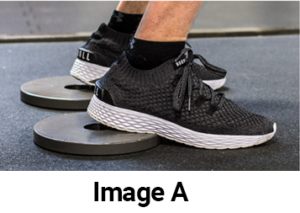
How many times have you watched students in a group exercise class perform a sequence of squats that look like the figures in image B? With proper cuing, some of these poor execution issues may be corrected. However, what if the student’s poor execution techniques are caused by restrictions in their ankle, hip, core, &/or shoulder?
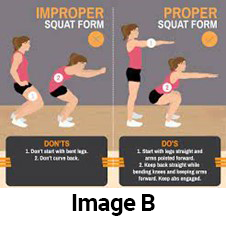 What about studio cycling classes? Do you see some of the strongest students hit a plateau while doing a power training ride? Yes, they ride 3 to 5 times per week and they cross train with weights, but do they incorporate any recovery training?
What about studio cycling classes? Do you see some of the strongest students hit a plateau while doing a power training ride? Yes, they ride 3 to 5 times per week and they cross train with weights, but do they incorporate any recovery training?
How can we, as Personal Trainers, Group Exercise Instructors and Sports Conditioning Specialists address length/tension relationship imbalances, restore and align mobile joints, and connect the brain and body into movement training with CNS stimuli that can get our members to reach their training goals and objectives?
Meet the RAMP Method
What is The RAMP Method and how can it help you become a better practitioner?
This unique technique is a 4-Phase, total mind/body training program that creates multi-planar movement patterns and exercises around an activated core. The acronym stands for Restore, Align, Maintain, & Progress.
STEP #1: Assessment
First, determine if your student/client can safely engage in physical activity, so a quick assessment is performed. Assessments provide an understanding of an individual’s mobility/stability and compensation factors (if any). It is important to assess the three most mobile joints; the ankle, hip, and shoulder, as well as the core:
Ankle – Dorsiflexion
Hip – Duncan-Ely
Core – Active straight leg lower
Shoulder – Overhead flexion
Knowing if this individual can perform a proper squat or pushup out on the training floor based on these basic, baseline measurements will help you have a clear picture of available system resources, or rather what movement capacity a client has. Another benefit is that these results serve as comparisons to future evaluations and can showcase progress.
STEP #2: RESTORE:
When you know what resources are available to a person, you can develop a plan and clear up any restrictions in our RESTORE phase (if no restrictions exist, you are clear to move into the next phase). We use myofascial techniques to hydrate fascia and free up soft tissue that is congested, restricted, and/or tight. Tom Myers, Anatomy Trains, advises us to move in non-conventional movements in all planes.
Examples of both passive and active foam rolling techniques using the tools that are shown in image “C”.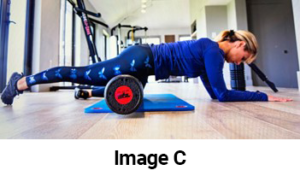
Additionally, The RAMP Method developed the R-S-C (RELEASE-STRETCH-CONTRACT) protocol to reintroduce the correct muscles back into the movement collective, so we stop moving in compensatory patterns. Once you’ve found more space to move in, with the core stabilizing the spine, get mobile joints to sit in their middle for aligned, fluid, balanced movement.
STEP #3: ALIGN:


The ALIGN phase is about feeling adduction. Why? It’s a natural response by our central nervous system to move our extremities towards the midline of our bodies and protect our organs. This innate defensive reflex is also a very strong joint action. We use elastic resistance to abduct limbs (the humerus and femur) to elicit a withdrawal response (we equate this to adduction) and train our very strong adductors in the body. There is evidence that the brain coordinates movement in specific slings in the body. Our programming goes after balancing the anterior and posterior oblique slings. We strive to activate the core in standing throughout our programming.
If you can ensure that the client can master 10 perfect repetitions, keeping the spine stable and joints aligned, then build strength in these new patterns and start adding load in the MAINTAIN phase.
STEP #4: MAINTAIN: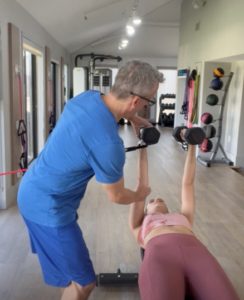
Any exercise with an added band is part of The RAMP Method Signature Series. In our Signature Series, we band into withdrawal because it elicits a central nervous system (CNS) response to a destabilizing event. Why do we see the value in destabilizing a system? It forces that system to adapt and connects the brain and body into the movement with this CNS stimuli. By adding load (i.e. weight such as dumbbells or kettlebells), we are providing stability to anchor the instability the band will create.
STEP #5: PROGRESS:
The final PROGRESS phase puts it all together to create a “Brainsweat” with multi-plane, multi-joint, coordinated, movement programming that combining everything. This is our way to get more of the body moving into new patterns – upper and lower body coordination/ left and right symmetry/ left lower and right upper connectivity. We have seen motor adaptations happen quicker with this type of training. You can train clients with less load and less volume, low impact, but high intensity and see fast results. This method has also been applied to programming in the group exercise setting.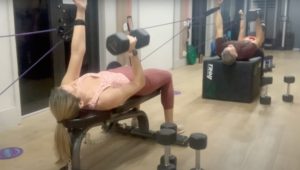
With The RAMP Method, we look at one’s movement through a closer lens and seek to correct protective patterns that the brain shutdown due to a trauma, dysfunction or compensation, and retrain pre-trauma movement patterns with light, springy movement behavior.
Whether you’re a personal trainer, small group coach, or group exercise instructor, we hope you will use The RAMP Method as a tool equipped with amazing programming that will give your clients/ students the results they are looking for while keeping them injury free and constantly progressing.
 About the Authors
About the Authors
Alison Robbins is dedicated to adjusting her own movement patterns with practical approaches she spent a career honing. This led her to co-create The RAMP Method. What sets Alison apart is her instruction that encourages personal best and holistic integration. Empathy for her clients permeates every set. She meets you exactly where you are and has made a welcoming environment at Meso Fit studio for students to develop practical fitness goals and healthy habits.
 Bryan Sobolewski began his career as a trainer to supplement his income while pursuing a bachelor’s degree in psychology, a subject that compliments his training style. Bryan’s holistic approach to treating movement dysfunction helped him develop The RAMP Method, the birth child of addressing his own muscular imbalances. Today, Bryan is happiest being the catalyst that helps each client achieve lasting results, constant progress, and a giggle or two.
Bryan Sobolewski began his career as a trainer to supplement his income while pursuing a bachelor’s degree in psychology, a subject that compliments his training style. Bryan’s holistic approach to treating movement dysfunction helped him develop The RAMP Method, the birth child of addressing his own muscular imbalances. Today, Bryan is happiest being the catalyst that helps each client achieve lasting results, constant progress, and a giggle or two.

Amplify Your Fitness Profession with Teaching Exchange Programs
by Anna Colosimo
Have you ever had the opportunity to learn about or participate in an exchange program? Maybe you thought about it when you were younger, perhaps you have hosted an exchange student, or your own children have been a part of a program. I personally wasn’t organized enough to be involved when I was younger, but the idea of being an exchange student has always allured me! On a different note, I was lucky enough to take a trip to Spain when I was 17, and never looked back after traveling internationally for the first time. Something about the combination of new cultures, different ways of life, exotic languages, discovering new foods and traditions just captured my soul…as travel does for many people.
The concept of the exchange program was founded in the United States under the Mutual Education and Cultural Exchange Act of 1961, on the premise that “one could increase understanding among people of different nations through promoting cultural understanding and education.” It sounds pretty spot on to me when it comes to travel and learning being under the same umbrella.
There is a similar concept- a term coined by our British friends across the pond- called a ‘gap’ year, that could be dropped into the travel or exchange program category. Often the gap year is between high school graduation and before deciding to enter a university. You can find gap year students usually raving about their wildly fulfilling trips and unique experiences across the globe. Wikipedia explains, “Gap years first became common in the 1960s where the young baby boom generation wanted to get away from the severity of war from their parent’s generation. At first, the primary purpose of the gap year was for countries to exchange cultural ideals in the hope of preventing future wars. The outcome of this exchange was the growth of the gap year industry.”
There is another entity that includes foreign commerce development, International Work Exchange programs, in where people and/or entire families that wish to see another part of the world for a period can partake. Many seek these opportunities to enhance educational, professional, or cultural learnings and opportunities. According to Alliance for International Exchange, “Exchange programs create opportunities: opportunities for participants to learn, prosper, and to work with others to solve shared problems and ensure a secure future. Exchanges create future leaders who instinctively appreciate the value of international collaboration, understanding, and empathy.”
While exchange programs and gap years sound wonderful, what about something that can fit into your current ‘season of life’ as a fitness professional or entrepreneur?
The thought of travel can be overwhelming for many people, and it’s always smart to know and explore the options available to you. Believe it or not, there is a program that has you dreaming like you are a gap-year-teenager, yet fully embraces where you and your business are right now. Enter the Teaching Vacation…just for fitness, sports, and yoga professionals.
The concept of a teaching vacation has been around since the early 90’s in the fitness industry. That means the idea of taking part in an exchange program or a gap year doesn’t have to be something that you only dreamed of in the past.
Besides the incredible benefits of travel, you can also fortify your fitness industry skills. Fitness Pro Travel, by Fit Bodies, Inc., offers teaching vacations where you earn CECs just by traveling with them. Among other opportunities to look forward to on a teaching vacation:
- Saving thousands of dollars on a weekly all-inclusive vacation for you and a companion (and your two children up to the age of 12 at family resorts)
- Rest and rejuvenation is necessary for you to bring your full energy to your classes, clients, and business. When was the last time you “allowed” yourself a vacation? Chances are it was years ago.
- Education! You learn a lot when teaching outside of your personal virtual or in-person studio.
- Adapt classes to various fitness levels
- Class participants speak a different language
- People that ‘stumbled’ upon your class on the beach or poolside and joined in
- Spontaneously provide modifications
- Be creative and work with your environment to give the best class atmosphere
- Earn .3 CECs for traveling and teaching (approved by ACE), soaking up the experience, and then completing an online course. These can be included in your teaching vacation at no extra cost.
Intrigued? Curious? Want to learn more about the concept of a teaching vacation for certified/licensed fitness pros, yoga, and sports professionals? Fitness Pro Travel can answer all your questions and concerns. Reach out for more information or create your free account on www.fitnessprotravel.com to get started! Mix your passion with paradiseÔ.
 About the Author, Anna Colosimo
About the Author, Anna Colosimo
Anna Colosimo is the Director of Partnerships and Business Development at Fit Bodies, Inc. She received her degree from the University of Dayton in Exercise Science and Fitness Management, and has always had a passion for the fitness, wellness, and health promotion since she was a young girl. She has 17 years working in the business side of the fitness industry, with extensive experience in fitness education, programming, working with gyms, and in partnership with other companies/organizations. Within the fitness industry, she has held various positions and worked for noted companies such as Zumba, Trigger Point Performance, and PTontheNet/FitPro UK. She loves bringing new opportunities and ideas to the fitness industry and professionals that benefit our industry and bring abundance to all.

Move over Cycling, Slide Boards are Back!
The 90’s Culture and Art of Sliding is Now for Every Body
Do you remember slide boards from the ‘90s? Have you ever trained on a slide board before? If yes, I’m guessing you probably were either just that cool, or a high school or collegiate athlete. More than likely the board you slid on was probably eight to ten feet long and your experience was through a coach who used them as a cross training tool to contribute to your overall athletic performance. Your mentor obviously understood the benefits of lateral training and wanted to give you an edge over everyone else. Kudos to them!
Even though I trained as a college athlete, (Bucky the Badger at the University of Wisconsin-Madison), I never actually slid until I was 30 years old. The hidden secret of the slide board was revealed to me by my friend and Brrrn business partner, Jimmy T. Martin, who trained on ten-foot boards as a wrestler at George Mason University. (Catch this fun story here on our Brrrn YouTube channel. Full disclosure, you may laugh, as Jimmy is a former copywriter and improv/sketch comedian in NYC.)
BRINGING ‘90s CULTURE BACK IN VOGUE
A fad in the ‘90s (remember Ben Stiller’s movie Heavy Weights?), Jimmy and I are now bringing the art of slide board training back and in vogue—and we’re expanding it to Every Body, beyond just seasoned athletes, with our signature Brrrn Board. If musicians today can remix classics from the past, we’ve given slide boards—a training tool since the ‘70s—a full makeover. And get this: Not only is working out on slide boards backed by science, our Brrrn Slide Board curriculum is officially accredited by the National Academy of Sports Medicine (NASM).
Why start sliding now on a slide board?
I never realized, until Jimmy explained to me, that most competitive athletes across almost all sports, train laterally on slide boards. Want to know why? Slide board training helps them move better multi-directionally, be it zig-zagging in football, side-shuffling in softball, wrestling or basketball, or juking in soccer. Chances are that if an athlete has won a major sporting event, they train on slide boards regularly—like tennis legend Andy Murray or Basketball Star Steph Curry (starts at 44 seconds).
Perhaps even more unique about a slide board, as I learned when co-developing with Jimmy, is when you shorten the length to five or six feet—an enhancement in our adjustable slide Brrrn board—you now make the art and benefits of sliding accessible to everyone. Take the ‘90s version, transforming and remixing into today’s version. Shortening the board to a distance of 6 feet makes it manageable to anyone under 6’4”.
But wait, it gets better.
Sliding and lateral training not only benefit your mind, body, and spirit—but Jimmy and I will go as far to say we believe slide boards are a longevity tool as well. They can help to prevent injury and, we believe, provide an excellent, safe form of cardio since it’s low-impact and easy on your joints. (I’m almost 40, so I can say that now.)
SLIDING IS GOOD FOR YOUR BRAIN AND SOUL
How so, you ask? Well, it offers a type of “free-falling”. (Insert Tom Petty music.) Let me explain. Sliding boards are a controlled, yet uncontrolled environment. You’re travelling in the X-plane left to right when you slide, versus the Y-plane, when you walk, bike, or row and there’s no pedals or seat to guide you to the other side. You’re on your own, hence “free-falling” when compared to cycling or rowing, which has you locked in a fixed position. There’s a spirit of “freeness” to sliding when going side to side on the board. This concept ups-the-ante for me and is what makes sliding exciting. Other than starting at the five-foot setting and graduating to the six-feet length, you’re on your own.
Sliding is especially good for your brain, since a first time experience requires new neuro-muscular recruitment patterns to form. This benefit actively recruits and forms new thought-muscle connections to ensure you safely get from bumper to bumper in the lateral plane of west to east motion—whereby you enlist a whole new cast of muscle systems. Side-to-side motion comes in handy later in in life to reduce falling in daily activities, like getting in and out of the shower. The muscles used when stepping out of the tub are the same muscles recruited by your brain when you slide.
SLIDING IS A LONGEVITY TOOL: LOW-IMPACT CARDIO + INJURY PREVENTION
Not only can sliding laterally offer low-impact cardio, but it strengthens your joints in the sub-lateral system—glutes, groin, QL muscles in your back, hip-flexors, and extensors, as well as other type 1 and type 2 muscles. Point being, we move too much in the sagittal plane—walk, jog, run, cycle, and row, possibly developing muscular imbalances and chronic injuries to the lower back, hips, knees, and ankles. Slide board training is an antidote to these historic pitfalls of repetitive overtraining. As a side note, sliding gets your heart rate up and can burn up to 500 calories in 30 minutes.
How can this form of exercise help runners? Get this. Marathon runners use slide boards to equalize and improve the function of their hip stabilizers. Distance running has a higher injury rate than most other sports. In this Dutch study, more than 700 participants in the 2005 Rotterdam Marathon were surveyed about injuries, and almost 55 percent of the respondents reported suffering at least one running-related leg injury within the preceding year. Nearly 18 percent developed an injury during the marathon itself. That’s a lot! The question is, how many of them cross trained laterally leading up to the race?
SLIDING IS A MULTIGENERATIONAL MOVEMENT
For the active aging population (which is 60 years and older), slide boards really can help. Sliding improves balance, coordination, and body awareness—known as proprioception, which is the ability of your brain coordinating with your muscles and joints to determine where they are in space. The real-life application here is fall prevention. Sliding may help reduce falling as we age.
As an additional bonus, lateral training on slide boards is weight-bearing, unlike cycling, for example, which is not. How come? When on a bike, your butt is on a seat, and the resistance is from the bike, however sliding, uses your own body mass and gravity as the resistance. With gravity being the resistor and not having a seat to help take the load off, your skeletal-muscular system, aka YOU, has to do the work to keep you upright and sliding.
The gains are tremendous for one very key reason. Sliding uses not only your leg muscles, but nearly every muscle in your body is recruited to move laterally. This helps prevent muscle loss and serves as a hermetic effect (low stressor) on your bones. A process called remodeling, growing bones, gets more and more important when we age.
Case in point, many Americans will stop exercising as they get older because they think aging makes them automatically less fit. Because of this, a vicious cycle begins. Becoming less fit, causes them to exercise even less. The scientific community calls it Sarcopenia, a loss of muscle mass and strength. Studies are now showing that resistance training, especially weight-bearing exercises—with special thanks to Supreme Court Justice Ruth Bader Ginsburg who lived into her 80s and put in the reps in the gym—can add years to your life. It’s never too late to add slide board training to your exercise routine.
LATERAL MOVEMENT CAN MOVE YOUR FITNESS FORWARD
In summary, slide board training is back! After trying the art of sliding one fall day back in 2014 in NYC, I fell in love. It was challenging and I wasn’t good at it, even though I was athletic and had good balance and coordination. I was sore the next day in many more ways than I’d ever been before! I knew immediately, that my brain and body was missing this form of lateral movement exercise my entire life. If only I knew at the time, I would be making a career out of bringing slide boards back via the Brrrn Board.
If you are interested in learning more about Brrn Slide Board Training, join Jimmy and me at SCW Boston MANIA®, November 11-13, at the Doubletree by Hilton Boston North Shore and register for the Fall Prevention Certification with Christine Conti, MEd, on Thursday, November 10.
Please reach out with any questions and find me on social media. www.thebrrrn.com, Instagram: @brrrn, @johnnyadamic, @jimmytmartin | Facebook: @thebrrrn, @johnnyadamic, @jimmytmartin Christine Conti, YouTube: Brrrn At-Home Use code SCW10 for 10% off Brrrn Boards, Brrrn Bundles, and the Brrrn Board Online Certification Course for .8 CEC’s with NASM and 8 credits with AFFA.
 About the Author, Johnny Adamic
About the Author, Johnny Adamic
Johnny Adamic is a Minneapolis-based entrepreneur and co-founder of Brrrn—the fitness brand behind the Brrrn Board. Adamic is a former public health official at the New York City Department of Health and Mental Hygiene and served on the Obesity Task Force established by Mayor Bloomberg. A registered yoga teacher and certified personal trainer (NASM), Adamic also wrote for The Daily Beast as a health, fitness, and food contributor. He graduated from the University of Wisconsin-Madison in 2006 with a BA in Journalism and Communication Theory and earned a master’s degree in Food Studies from New York University in 2010 in the Department of Nutrition, Food Studies, and Public Health.

Consistent Progress Vs. Dramatic Progress
The drama of dieting and extreme workouts can be compelling. Even the rollercoaster of restrictive eating, met by “you-deserve-this” eating, seems exciting and is often touted as impressive. For some, consistency may not seem dynamic enough to be goal worthy.
You’ll probably never see a Reality TV show highlight the beauty of consistency. However, evidence shows it is most effective to make small, sustainable changes in health behaviors over time.
Many fitness enthusiasts are falling into a fad diet trap leading to extremes that backfire. Though initially applaudable, restrictive eating plans fail because the initial weight loss is not sustainable. Extreme workouts that are excessively intense, and potentially injury-promoting, could be working against you as well, especially if proper rest and recovery isn’t prioritized.
These types of extremes are usually initiated for the purpose of weight loss. To break it down, consider the 3500-calorie deficit it takes over 7 days to lose a pound of fat tissue. If you are on track to lose 2 pounds of fat tissue per week, that would be a 12-pound loss after 6 weeks of careful intention Monday through Sunday: eating 500 less calories daily and burning 500 additional calories daily.
In real life this is quite challenging…potentially even all-consuming.
When it comes to the caloric intake aspect, think about an alternative, more sustainable, plan that includes three, 200-calorie splurges per week, for instance.
If you do the math, you’ll see that it would result in an 11-pound loss over the 6 weeks instead of 12 pounds. It’s not a big difference in how your jeans fit. By including a small, intentional treat or favorite snack a few times a week, one can enjoy a dramatically different lifestyle…one that doesn’t tempt someone to “cheat on their diet,” forgo social gatherings, and go into “I-deserve-this mode” on the weekends.
Righteously restricting your favorite splurges may have a halo effect but can often lead to binging on these foods later, which could result in overconsumption and eventually the desire to quit making healthy efforts altogether. This is because the “going-hard or going-home” theory
makes you want to just go home, or because the imminent mini-binge episodes negate the results you want to see (or both.)
Ultimately, a sustainable plan results in more pounds lost because it is realistic. Consistency beats drama in the long game, not to mention that social and emotional health can be maintained along the journey.
The key is that the splurges are strategic and savored mindfully, rather than gobbled up guiltily. If you allow yourself to slowly eat dark chocolate and fully appreciate it in small amounts, for example, rather than eliminating it from your diet completely, it may put you at a lower risk of giving up, and potentially reversing your progress.
Being strategic and consistent (rather than dramatic) ends the vicious cycle:
Starve > Stuff > Start again.
Think of these discretionary calories as allocated spending money. You get to spend it however you decide is best, but once it’s gone for the week, it’s gone. It’s up to you how you spend this “cash”. You’ll need to make a flexible plan to use it wisely. (Note: this is referring to the discretionary calories in discussion, not the calories that meet the demands of your body’s basic functions at rest.)
Maybe this weekend you know you’ll be offered cake and ice cream for a friend’s birthday: look ahead and decide if that’s where you want to spend your budget. You may decide a glass of wine (5-ounces) with a square of dark chocolate every other night (3 days of the week) would be your preference for indulgence instead.
Imagine how different you would feel in your skin, and about your choices, if you were strategic and fully present while eating, instead of restrictive or disinhibited when it comes to what you consume.
Regular and energizing workouts, as well as savored, planned splurges can help you reach your goal without giving up. Legitimate, lasting wellness is a journey, not a destination. It’s not all or nothing.
Consistency may seem less than sexy, but the result of steady imperfect progress is what ultimately gives you confidence. Not to mention, it allows you to enjoy the journey and still get results (the kind that don’t backfire or compromise your metabolism).
Use this Meals & Movement Template here to make out a plan for consistent fueling with healthy food, meaningful movement, and strategic splurges (if they’re worth it) …and let the drama go.
 About the Author, Sohailla Digsby
About the Author, Sohailla Digsby
Sohailla Digsby is a registered dietitian, author, and the developer of the 52-day Best Body Countdown program for gyms to provide the missing pieces of the fitness puzzle: nutrition and
accountability. With over 25 years of experience as a fitness pro and RD, Sohailla provides nutrition coaching and runs an online membership-based group. She has authored three books to help fitness professionals guide their clients to their goals. Her programs are not just about the weight you lose, but the life you gain!
 We’re always looking for great content highlighting the newest things in the world of fitness. Please submit your article directly to editor@scwfit.com for immediate consideration!
We’re always looking for great content highlighting the newest things in the world of fitness. Please submit your article directly to editor@scwfit.com for immediate consideration! Spotlite, April 16, 2025
Spotlite, January 5, 2025
Spotlite, November 11, 2024
Spotlite, September 27, 2024
Spotlite, August 31, 2024
Spotlite, July 26, 2024
Spotlite, June 22, 2024
Spotlite, May 23, 2024
Spotlite, April 26, 2024
Spotlite, March 22, 2024
Spotlite, February 19, 2024
Spotlite, January 20, 2024
Spotlite, December 21, 2023
Spotlite, November 18, 2023
Spotlite, October 22, 2023
Spotlite, September 21, 2023
Spotlite, August 19, 2023
Spotlite, July 19, 2023
Spotlite, June 19, 2023
Spotlite, May 18, 2023
Spotlite, April 21, 2023
Spotlite, March 28, 2023
Spotlite, February 18, 2023
Spotlite, January 21, 2023
Spotlite, December 16, 2022
Spotlite, November 19, 2022
Spotlite, October 22, 2022
Spotlite, September 24, 2022
Spotlite, August 23, 2022
Spotlite, July 22, 2022
Spotlite, June 20, 2022
Spotlite, May 18, 2022
Spotlite, April 20, 2022
Spotlite, March 25, 2022
Spotlite, February 17, 2022
Spotlite, January 14, 2022
Spotlite, December 17, 2021
Spotlite, November 18, 2021
Spotlite, October 25, 2021
Spotlite, September 16, 2021
Spotlite, August 9, 2021
Spotlite, July 10, 2021
Spotlite, June 8, 2021
Spotlite, May 14, 2021
Spotlite, April 30, 2021
Spotlite, March 30, 2021
Spotlite, February 23, 2021
Spotlite, January 20, 2021
Hyatt Regency Dulles
Herndon, VA
Hyatt Regency SF Airport
Burlingame, CA
Caribe Royale Orlando
Orlando, FL
May 1-4, 2025
May 2026
Grand Hyatt Atlanta Buckhead
Atlanta, GA
July 24-27, 2025
July 2026
Westin Galleria Dallas
Dallas, TX
August 21-24, 2025
August 28-30 2026
Rosemont Chicago O’Hare
Rosemont, IL
Oct. 2-5, 2025
Oct. 2-4 2026
Doubletree by Hilton
Danvers, MA
Nov. 13-16, 2025
Nov. 13-15, 2026


